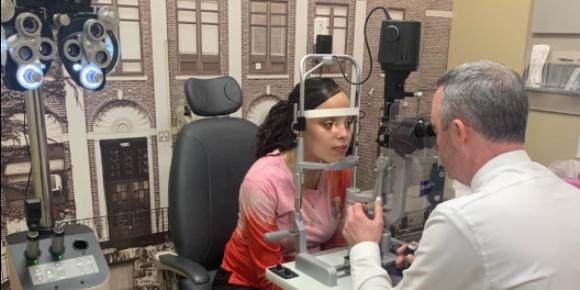Read Our Blog

Amblyopia: Understanding the 'Lazy Eye' and Its Impact on Vision
- posted: Mar. 14, 2024
Amblyopia, commonly known as a "lazy eye," is a vision disorder that can affect both children and adults. Despite its colloquial name, amblyopia is far more than a mere aesthetic concern. In this blog post, we'll explore the intricacies of amblyopia, shedding light on its causes, symptoms, and the importance of early detection and intervention in preserving optimal vision.
Defining Amblyopia
Amblyopia is a condition where one eye develops weaker vision than the other, leading to a significant imbalance in visual acuity. This discrepancy is not due to any structural abnormalities or eye diseases but arises from the brain favoring one eye over the other during crucial developmental stages.
Causes and Risk Factors
The primary cause of amblyopia is often related to an imbalance in the alignment of the eyes, refractive errors (such as nearsightedness, farsightedness, or astigmatism), or a combination of both. Other factors contributing to amblyopia include a family history of the condition, premature birth, and certain eye conditions that obstruct the visual pathway.
Symptoms of Amblyopia
Amblyopia often presents without any visible signs or symptoms, making it challenging to detect without a comprehensive eye examination. In some cases, parents may notice that a child consistently tilts or turns their head to one side, experiences difficulties with depth perception, or has one eye that appears to wander. Regular eye check-ups are crucial for identifying amblyopia early.
Diagnosis and Early Intervention
Diagnosing amblyopia typically involves a comprehensive eye examination, including visual acuity tests and an assessment of eye alignment. Early detection is essential, especially during childhood when the visual system is still developing. Prompt intervention, such as prescribing glasses or contact lenses and implementing eye patches or eye drops to encourage the use of the weaker eye, can be highly effective in improving visual outcomes.
Treatment Approaches
The primary goal of treating amblyopia is to encourage the brain to recognize and use the weaker eye, promoting equal visual acuity between both eyes. Treatment options may include corrective lenses, eye patches, atropine eye drops, or, in some cases, vision therapy. Successful treatment often hinges on consistent and early intervention, ideally before the age of seven when the visual system is more malleable.
Long-Term Impact and Prevention
Without intervention, amblyopia can have lasting effects on visual acuity, potentially impacting academic performance, occupational choices, and overall quality of life. Regular eye check-ups, especially for children, are crucial in detecting and addressing vision issues early on, reducing the risk of amblyopia and other vision disorders.
Amblyopia is more than just a cosmetic concern; it is a vision disorder that requires early detection and intervention for optimal outcomes. Understanding the causes, recognizing potential symptoms, and prioritizing regular eye check-ups are essential steps in addressing amblyopia effectively.
By fostering awareness and seeking timely treatment, we can collectively work towards ensuring that individuals with amblyopia can enjoy a future with clear and balanced vision.
Contact Family Vision Center today for a comprehensive eye exam. Visit ct-eyecare.com.

Amblyopia: Understanding the 'Lazy Eye' and Its Impact on Vision
- posted: Mar. 14, 2024
Amblyopia, commonly known as a "lazy eye," is a vision disorder that can affect both children and adults. Despite its colloquial name, amblyopia is far more than a mere aesthetic concern. In this blog post, we'll explore the intricacies of amblyopia, shedding light on its causes, symptoms, and the importance of early detection and intervention in preserving optimal vision.
Defining Amblyopia
Amblyopia is a condition where one eye develops weaker vision than the other, leading to a significant imbalance in visual acuity. This discrepancy is not due to any structural abnormalities or eye diseases but arises from the brain favoring one eye over the other during crucial developmental stages.
Causes and Risk Factors
The primary cause of amblyopia is often related to an imbalance in the alignment of the eyes, refractive errors (such as nearsightedness, farsightedness, or astigmatism), or a combination of both. Other factors contributing to amblyopia include a family history of the condition, premature birth, and certain eye conditions that obstruct the visual pathway.
Symptoms of Amblyopia
Amblyopia often presents without any visible signs or symptoms, making it challenging to detect without a comprehensive eye examination. In some cases, parents may notice that a child consistently tilts or turns their head to one side, experiences difficulties with depth perception, or has one eye that appears to wander. Regular eye check-ups are crucial for identifying amblyopia early.
Diagnosis and Early Intervention
Diagnosing amblyopia typically involves a comprehensive eye examination, including visual acuity tests and an assessment of eye alignment. Early detection is essential, especially during childhood when the visual system is still developing. Prompt intervention, such as prescribing glasses or contact lenses and implementing eye patches or eye drops to encourage the use of the weaker eye, can be highly effective in improving visual outcomes.
Treatment Approaches
The primary goal of treating amblyopia is to encourage the brain to recognize and use the weaker eye, promoting equal visual acuity between both eyes. Treatment options may include corrective lenses, eye patches, atropine eye drops, or, in some cases, vision therapy. Successful treatment often hinges on consistent and early intervention, ideally before the age of seven when the visual system is more malleable.
Long-Term Impact and Prevention
Without intervention, amblyopia can have lasting effects on visual acuity, potentially impacting academic performance, occupational choices, and overall quality of life. Regular eye check-ups, especially for children, are crucial in detecting and addressing vision issues early on, reducing the risk of amblyopia and other vision disorders.
Amblyopia is more than just a cosmetic concern; it is a vision disorder that requires early detection and intervention for optimal outcomes. Understanding the causes, recognizing potential symptoms, and prioritizing regular eye check-ups are essential steps in addressing amblyopia effectively.
By fostering awareness and seeking timely treatment, we can collectively work towards ensuring that individuals with amblyopia can enjoy a future with clear and balanced vision.
Contact Family Vision Center today for a comprehensive eye exam. Visit ct-eyecare.com.
Locations
Office & Optical Hours
Office Hours
Monday, Tuesday, Friday
9:00 am - 5:30 pm
Wednesday, Saturday
8:30 am - 3:00 pm
Thursday
9:00 am - 7:00 pm
Sunday
Closed
Optical Hours
Monday, Tuesday, Friday
9:00 am - 4:30 pm
Wednesday, Saturday
8:30 am - 2:00 pm
Thursday
9:00 am - 6:00 pm
Sunday
Closed


